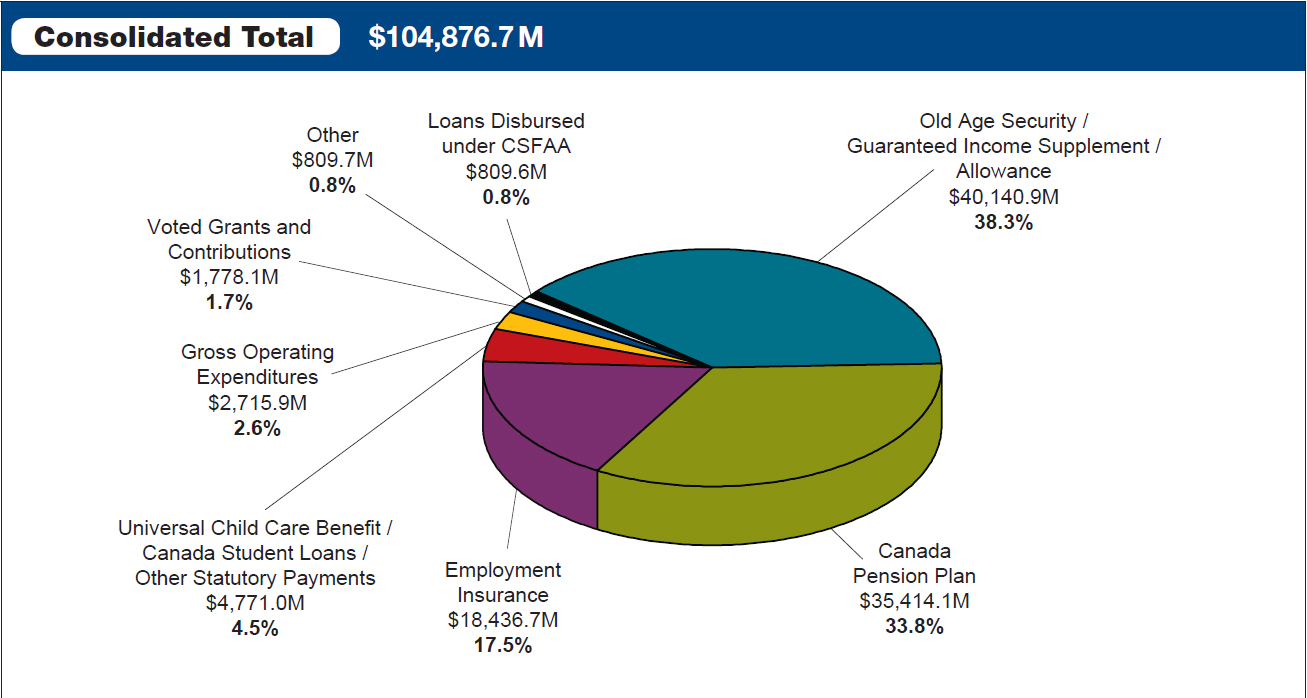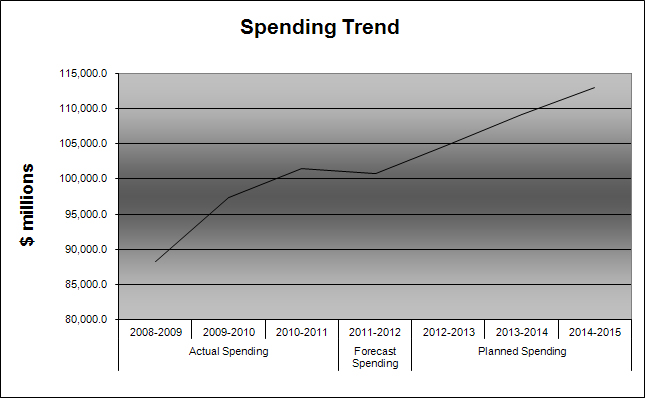Common menu bar links
Breadcrumb Trail
ARCHIVED - Human Resources and Skills Development Canada - Report
 This page has been archived.
This page has been archived.
Archived Content
Information identified as archived on the Web is for reference, research or recordkeeping purposes. It has not been altered or updated after the date of archiving. Web pages that are archived on the Web are not subject to the Government of Canada Web Standards. As per the Communications Policy of the Government of Canada, you can request alternate formats on the "Contact Us" page.
Ministers' Messages
Message from the Minister of Human Resources and Skills Development

I am pleased to present to Parliament the 2012-2013 Report on Plans and Priorities for Human Resources and Skills Development (HRSDC).
HRSDC is helping to build a stronger and more competitive Canada.
HRSDC interacts directly with Canadians at many stages of their lives. Whether it is by providing parents with choice in childcare, assisting persons with disabilities to re-enter the workforce, supporting summer job opportunities for youth to gain work experience, promoting volunteerism and innovative social partnerships or ensuring that seniors have sustainable retirement benefits, my Department is supporting Canadians and their families.
Our Government's top priority continues to be job creation, economic growth and Canada's long-term prosperity. To help address Canada's labour and skills shortages, we are taking action now to strengthen our labour market. In the coming year, we will prioritize skills training, post-secondary education, labour mobility, and foreign credential recognition.
My Department will continue to improve the efficiency with which programs are delivered to Canadians. By providing more responsive, flexible and timely service, we will ensure the greatest respect for taxpayers' dollars.
HRSDC will continue to deliver the programs and services that matter most to Canadians - for today and for tomorrow
The Honourable Diane Finley, P.C., M.P.
Minister of Human Resources and Skills Development
Message from the Minister of Labour

The Government of Canada is committed to promoting strong, healthy and productive workplaces for all Canadians. The Labour Program supports these goals, which are key to a healthy economy in Canada.
In 2012-2013, the Labour Program will focus on two key priorities: modernizing its programs and operations, and expanding the Preventive Mediation Program.
To fulfil the needs of employers and employees, we will continue our work to modernize federal labour legislation by further developing our compliance strategy related to Part II (Occupational Health and Safety) and Part III (Labour Standards) of the Canada Labour Code. Our modernization efforts will also include efforts to reduce red tape and the burden on small businesses.
The amendment to the Wage Earner Protection Program Act in Budget 2011 will continue to enhance protection for Canadians by extending coverage entitlement for employees who lose their jobs when their employer's attempt at restructuring is unsuccessful and ends in bankruptcy or receivership.
The most recent data showed that where the Labour Program assisted parties during the collective bargaining process, 94% of disputes were settled. We will expand the Preventive Mediation Program aimed at resolving workplace differences and improving labour relations while a collective agreement is in force.
The Labour Program will also implement a Canada Labour Code amendment which prevents employers under federal jurisdiction from setting a mandatory retirement age, unless there are legitimate health and safety concerns.
Internationally, the Labour Program will maintain its leadership role in implementing strong labour cooperation agreements. Our goal is to achieve decent working conditions for all workers and a level playing field for businesses dealing with Canada's trade partners.
The Labour Program is committed to protecting workers, supporting strong labour-management relations, encouraging equality in the workplace and playing a leadership role in international labour affairs. This has been the case for the past and it will continue to be so as we look towards the future.
The Honourable Lisa Raitt, P.C., M.P.
Minister of Labour
Section 1: Departmental Overview
1.1 Raison d'être
Human Resources and Skills Development Canada's (HRSDC) mission is to build a stronger and more competitive Canada, to support Canadians in making choices that help them live productive and rewarding lives, and to improve Canadians' quality of life.
1.2 Responsibilities
HRSDC is responsible for designing and delivering some of the Government of Canada's most well-known statutory programs and services, including:
- Old Age Security
- Canada Pension Plan
- Employment Insurance
- Canada Student Loans and Grants
- National Child Benefit
- Universal Child Care Benefit
These direct benefits to Canadians are part of Canada's social safety net and represent almost 95 percent of the Department's expenditures.
Central to the Department's raison d'être are activities which:
- support a flexible, national labour market;
- increase participation in the labour force;
- remove barriers to post-secondary education and skills development;
- oversee federal labour responsibilities;
- provide income support to seniors, families with children and Employment Insurance beneficiaries; and
- deliver Government of Canada programs and services on behalf of other departments and agencies.
Service Canada helps citizens access HRSDC's programs, as well as other Government of Canada programs and services, online at www.servicecanada.gc.ca, by telephone through 1 800 O-Canada, and at more than 600 points of service across the country through its network of program-based call centres. In 2012-2013, HRSDC will continue to play a key role in delivering programs and services for citizens and employers as they adapt to changing economic conditions and prepare for the future.
Through the Labour Program, the Department is responsible for overseeing federal labour responsibilities, including labour laws; occupational health and safety; labour standards; labour relations and mediation services in federally regulated workplaces. The Labour Program also represents Canada in international labour organizations and negotiates labour cooperation agreements as part of free-trade negotiations.
Finally, grants and contributions funding is provided to other levels of government and organizations to support projects that meet the labour market and social development needs of Canadians.
1.3 Strategic Outcomes and Program Activity Architecture

[text version of image : HRSDC's Program Activity Architecture]
1.4 Organizational Priorities
As a large organization, the Department will continue to adapt to an ever-changing environment. This environment is characterized by the significant demographic changes in Canadian society, changing economic conditions impacting on social and economic opportunities for Canadians and rising service expectations. At the same time the Department will focus on increased cost efficiency, supported by sound financial management.
Over the next few years, the Department will be transformed to achieve better results for Canadians. HRSDC will become more focused on its core business and become more efficient in developing policies, delivering programs and managing operations, and will modernize the way services to Canadians are delivered.
The priorities listed below demonstrate the increasing momentum of the transformation agenda that began last year, including new changes to its core business in support of the Government of Canada's policy agenda:
| Priority | Type | Strategic Outcome(s) and/or Program Activity(ies) |
|---|---|---|
| Service Delivery Business Transformation | Continuing from previous years | 1, 3, 4 |
| Status | ||
|
Why is this a priority? Service Canada is the face of the Government of Canada to Canadians. Citizens have evolving needs and rising service delivery expectations. They want organized one-stop government services that meet their individual requirements and are offered in a way they can trust. This includes accessing the services they need around the clock with confidence that their privacy and personal information is appropriately managed and safeguarded during its collection, retention, use, disclosure and disposal. Demographic changes will also influence the way services are delivered in the future. In particular, increases in life expectancy and Canada's aging population are expected to significantly increase the number of Canada Pension Plan (CPP) and Old Age Security (OAS) beneficiaries, as well as increase demand for services related to these programs. Today's seniors' service preferences and expectations will differ from those of their predecessors and Service Canada must respond to these evolving needs. Service improvements in these areas will be critical to meet expectations and contain costs. New and emerging technologies will create opportunities to respond to evolving client preferences. These technologies will improve services, modernize and automate the delivery of the Department's largest programs, including Employment Insurance (EI), CPP and OAS. Through service delivery business transformation, Service Canada will simplify service delivery, make more services available online and improve operational efficiency. Further, grants and contributions are a key mechanism to pursue public policy goals through targeted programming. We will continue modernizing grants and contributions delivery by standardizing applications and agreements, streamlining administrative processes, improving access and awareness of programs through improvements to the website so applicants can more easily identify funding opportunities. On-line services and tiered program delivery are under development, as well as a portfolio-wide training strategy. Plans for meeting the priority
|
||
| Priority | Type | Strategic Outcome(s) and/or Program Activity(ies) |
|---|---|---|
| Enabling Services Renewal Program | Continuing from previous years | Internal Services |
| Status | ||
|
Why is this a priority? HRSDC needs to operate more efficiently to achieve better value for money and results for Canadians. To support that goal, internal services and processes must become more efficient for human resources management, financial and material management, information technology, learning and departmental security. The multi-year Enabling Services Renewal Program (ESRP) is transforming the delivery of internal services in HRSDC to create an integrated, client-centered service delivery model. This program of change includes the following projects: the implementation of new Enterprise Resource Planning (ERP) Systems (i.e., PeopleSoft for Human Resources and SAP for Finance and Materiel) to replace aging legacy systems, and a service delivery transformation initiative that includes a client-centred Click-Call-Consult model based on the Service Canada Click-Call-Visit service delivery model. The ESRP will result in an improved enterprise approach to delivering service to employees, increased value for money and improved stewardship. Plans for meeting the priority
|
||
| Priority | Type | Strategic Outcome(s) and/or Program Activity(ies) |
|---|---|---|
| Modernizing and improving our policies and programs | New | 1, 2, 3 |
| Status | ||
|
Why is this a priority? HRSDC has a broad mandate and must continually adapt its programs to support the Government of Canada's policy agenda and respond to Canadians' changing needs. The learning and employment-related programs, including Employment Insurance (EI), must remain effective in addressing both short-term economic conditions and longer-term challenges in the Canadian labour market, including a shrinking labour force as the population ages. An aging population also drives the Department to examine its programs that support seniors. Plans for meeting the priority
|
||
| Priority | Type | Strategic Outcome(s) and/or Program Activity(ies) |
|---|---|---|
| Supporting employees, maintaining effective management practices and continuing to support public service renewal | Ongoing | All |
| Status | ||
|
Why is this a priority? The Department earns the trust and confidence of Canadians and its partners by:
The Department relies on this trust to fulfil its mission and deliver results for Canadians. In this context, program integrity, sound financial management and meeting the highest standards of respect for the privacy of personal information are vital to its continued success as an organization. A well-trained, motivated and enabled workforce is a key in HRSDC fulfiling its mandate. HRSDC is pursuing an ambitious agenda for change to position the Department for the future. Supporting employees through these changes and building the competencies required to meet the Department's changing needs is essential. Plans for meeting the priority
|
||
1.5 Corporate Risk Analysis
The Department has identified the following corporate risks and mitigation strategies for 2012-2013:
- Transformation Agenda
- Privacy
- Information Technology
- Human Resource Management
Transformation Agenda
HRSDC is undertaking a significant transformation agenda with several large, complex, horizontal change initiatives.
- the Department’s ability to implement an ambitious change agenda, including several internal business transformation initiatives;
- specific resource capacity within the enabling services branches to deliver on these multiple, competing and interdependent projects; and
- resource capacity related to project management, which will be essential to successfully implement the overall transformation agenda.
HRSDC’s integrated business plan supports the various transformation initiatives, and a departmental governance structure is in place to manage the change agenda. Numerous mitigation strategies are in place in order to effectively monitor and report on progress, mechanisms exist for identifying and reacting to any escalating risks in a timely fashion, and increased integration of the Department’s enabling branches will allow the Department to effectively manage these change agenda risks. Continuous adjustments to the Information Technology Services Model, Investment Plan, Workforce Management Strategy, National Learning Policy and Leadership Strategy, and other human resources and financial management tools will also help mitigate risks.
Privacy
Privacy protection is critical to maintain Canadians' trust—an essential precursor to their willingness to share information and make electronic transactions. To this end, the federal Privacy Act includes a code of fair practices concerning the collection, use, disclosure, retention and disposal of personal information. In the federal government, HRSDC is the custodian of the most detailed and complete set of records and, as such, has numerous systems in place to protect the personal information databases that the Department manages. In addition, the set of Privacy Codes contained within the Department's enabling legislation imposes rules for information use and availability that exceed Privacy Act requirements, with significant penalties for the misuse of personal information.
To help ensure the protection of personal information and respect for the privacy of Canadians, HRSDC will continue to strengthen its privacy management and assurance. Robust mitigation of this risk is ongoing, including awareness and training strategies, as well as continued implementation of the Department's Privacy Management Framework.
Information Technology
The Department invests in information technology (IT) business applications on an ongoing basis, continuously replacing obsolete or inadequate software and acquiring new technologies as required. Challenges related to supporting older applications and addressing gaps in software solutions create risks in terms of the Department's ability to manage operations effectively.
Going forward, HRSDC will need to continue positioning its investments within the broader context of its priorities and plan appropriately for ongoing maintenance. To do this, the Department will identify at-risk applications and any opportunities to consolidate applications and replace custom development with commercial off-the-shelf software where possible. HRSDC will align software with government-wide services (such as Shared Services Canada) and standards, while ensuring that costs for new technologies include the investment required for employee training.
Human Resource Management
The Department's change agenda and aging workforce, will require a highly-skilled, adaptive labour force and ongoing effective leadership in order to position HRSDC successfully for transition.
A greater focus on multi-year integrated business planning, supported by an effective workforce management strategy, will allow the Department to have the right people in the right place at the right time. ESRP will provide support and simplified, streamlined and integrated internal services that enable managers and employees to accomplish their business objectives. HRSDC will adopt a national learning strategy and seek new learning technologies to support its employees, as well as a leadership strategy to give leaders tools to help them create and sustain a healthy and enabling workplace.
1.6 Planning Summary
Financial Resources ($ millions)
| 2012-2013 | 2013-2014 | 2014-2015 |
|---|---|---|
| 104,876.0 | 109,130.8 | 113,027.6 |
Human Resources (FTEs)
| 2012-2013 | 2013-2014 | 2014-2015 |
|---|---|---|
| 22,719 | 21,738 | 21,483 |
| Program Activity | Forecast Spending 2011-2012 ($ millions) |
Planned Spending ($ millions) |
Alignment to Government of Canada Outcomes | ||
|---|---|---|---|---|---|
| 2012-2013 | 2013-2014 | 2014-2015 | |||
| Skills and Employment | 19,945.7 | 20,417.3 | 20,427.2 | 20,033.2 | Income security and employment for Canadians |
| Learning | 3,259.8 | 2,783.8 | 2,743.3 | 2,682.2 | An innovative and knowledge-based economy |
| Total Planned Spending | 23,205.5 | 23,201.1 | 23,170.5 | 22,715.4 | |
| Program Activity | Forecast Spending 2011-2012 ($ millions) |
Planned Spending ($ millions) |
Alignment to Government of Canada Outcomes | ||
|---|---|---|---|---|---|
| 2012-2013 | 2013-2014 | 2014-2015 | |||
| Labour | 309.5 | 286.5 | 289.5 | 293.4 | A fair and secure marketplace |
| Total Planned Spending | 309.5 | 286.5 | 289.5 | 293.4 | |
| Program Activity | Forecast Spending 2011-2012 ($ millions) |
Planned Spending ($ millions) |
Alignment to Government of Canada Outcomes | ||
|---|---|---|---|---|---|
| 2012-2013 | 2013-2014 | 2014-2015 | |||
| Income Security | 71,264.4 | 75,722.2 | 80,110.4 | 84,561.5 | Income security and employment for Canadians |
| Social Development | 2,949.3 | 3,007.2 | 3,004.8 | 2,911.7 | A diverse society that promotes linguistic duality and social inclusion |
| Total Planned Spending | 74,213.7 | 78,729.4 | 83,115.2 | 87,473.2 | |
| Program Activity | Forecast Spending 2011-2012 ($ millions) |
Planned Spending ($ millions) |
Alignment to Government of Canada Outcomes | ||
|---|---|---|---|---|---|
| 2012-2013 | 2013-2014 | 2014-2015 | |||
| Citizen-Centred Service | 494.0 | 400.2 | 391.0 | 390.2 | A transparent, accountable and responsive federal government |
| Integrity and Processing | 827.8 | 618.0 | 580.4 | 579.0 | A transparent, accountable and responsive federal government |
| Total Planned Spending | 1,321.8 | 1,018.2 | 971.4 | 969.2 | |
| Program Activity | Forecast Spending 2011-2012 |
Planned Spending | ||
|---|---|---|---|---|
| 2012-2013 | 2013-2014 | 2014-2015 | ||
| Internal Services | 939.8 | 831.1 | 772.3 | 766.8 |
| Total Planned Spending | 939.8 | 831.1 | 772.3 | 766.8 |
1.7 Contribution to the Federal Sustainable Development Strategy
The Federal Sustainable Development Strategy (FSDS) outlines the Government of Canada's commitment to improving the transparency of environmental decision making by articulating its key strategic environmental goals and targets. HRSDC ensures that consideration of these outcomes is an integral part of its decision-making processes. In particular, through the federal Strategic Environmental Assessment (SEA) process, any new policy, plan or program initiative includes an analysis on attaining the FSDS goals and targets. SEA results are made public when an initiative is announced, demonstrating the Department's commitment to achieving the FSDS goals and targets.
HRSDC contributes to Theme IV – Shrinking the Environmental Footprint – Beginning with Government, as denoted by the symbol below. Departmental Initiatives include paper reduction though printer consolidation, document imaging and expanded on-line services and information for both employees and Canadians. For more details on how HRSDC supports sustainable development, see Section
III of this Report (Greening Government Operations). Complete details about the Federal Sustainable Development Strategy are available from Environment Canada.

1.8 Expenditure Profile
For 2012–2013, the Department has planned expenditures on programs and services of $104.9B. Of that amount, $99.6B directly benefit Canadians through statutory transfer payment programs, such as Employment Insurance, Canada Pension Plan, Universal Child Care Benefit, Old Age Security, as well as loans disbursed under the Canada Student Financial Assistance Act.
 |
||
| Human Resources and Skills Development Canada - Gross Expenditures (in millions of dollars) |
||
|---|---|---|
| Budgetary | ||
| Net Operating Costs | 1,007.5 | |
| Add Recoveries in relation to: | ||
| Canada Pension Plan | 279.2 | |
| Employment Insurance Operating Account | 1,297.6 | |
| Workers' Compensation | 117.5 | |
| Other | 14.1 | 1,708.4 |
| Gross Operating Costs | 2,715.9 | |
| Voted Grants and Contributions | 1,778.1 | |
| Total Gross Expenditures | 4,494.0 | |
| Other - Workers' Compensation and EI/CPP Charges and Recoveries | 809.7 | |
| Non-Budgetary | ||
| Loans disbursed under Canada Student Financial Assistance Act (CSFAA) | 809.6 | |
| Statutory Transfer Payments (in millions of dollars) | ||
| Grants and Contributions: | ||
| Old Age Security | 30,574.3 | |
| Guaranteed Income Supplement | 9,003.6 | |
| Allowance | 563.0 | |
| Other Statutory Payments: | ||
| Universal Child Care Benefit | 2,747.0 | |
| Canada Student Loans | 995.0 | |
| Canada Education Savings Grant | 730.0 | |
| Canada Disability Savings Program | 115.4 | |
| Canada Learning Bond | 91.0 | |
| Wage Earner Protection Program | 54.2 | |
| Pathways to Education | 6.0 | 4,738.6 |
| Sub-Total | 44,879.5 | |
| Canada Pension Plan benefits | 35,414.1 | |
| Employment Insurance benefits | ||
| Part I | 16,314.0 | |
| Part II | 2,122.7 | 18,436.7 |
| Other Specified Purpose Accounts | 32.4a | |
| Total Statutory Transfer Payments | 98,762.7 | |
| a This amount includes payments related to Government Annuities Account, the Civil Service Insurance Fund and the Canada Millennium Scholarship Foundation Excellence Awards Fund. | ||
The figure below illustrates Human Resources and Skills Development trend from 2008-2009 to 2014-2015. For the 2012-2013 fiscal year, Human Resources and Skills Development plans to spend $104.9 billion to meet the expected results of its program activities. For the 2008-2009 to 2011-2012 periods, the total spending includes all Parliamentary appropriation and revenue sources, Main Estimates and Supplementary Estimates. For the 2012-2013 to 2014-2015 periods, total spending corresponds to planned spending. Increases in planned spending in 2012 – 2013 and beyond are based on changes in Old Age Security average rates of payment and population, and to increases in Canada Pension Plan benefits which reflect forecast of clients’ population and average benefit payments.
Spending Trend

| Actual Spending | Forecast Spending | Planned Spending | ||||
|---|---|---|---|---|---|---|
| 2008-2009 | 2009-2010 | 2010-2011 | 2011-2012 | 2012-2013 | 2013-2014 | 2014-2015 |
| 88,264.2 | 97,402.7 | 101,467.2 | 100,794.8 | 104,876.0 | 109,130.8 | 113,027.6 |
In 2009-2010, actual expenditures were $9.1 billion higher than in 2008-2009. This increase can be mainly explained by a $3.6 billion increase in Employment Insurance benefits and administrative costs due to the economic downturn, a $2.3 billion increase for initiatives announced in Canada's Economic Action Plan, a $1.4 billion increase in Canada Pension Plan benefits, and a $1.3 billion increase in Old Age Security payments due to changes in the number of beneficiaries and the average monthly rate.
In 2010-2011, actual expenditures were $4.1 billion higher than in 2009-2010. This increase can be mainly explained by a payment of $2.9 billion for temporary Employment Insurance benefit enhancement measures in accordance with the Budget Implementation Act (2009), a $1.2 billion increase in Canada Pension Plan benefits and a $1.0 billion increase in Old Age Security payments due to the aging population and the increase in the monthly benefit amount. There is also a decrease of $1.7 billion to Employment Insurance benefits, mainly due to a decrease in the average unemployment rate from 8.4% in 2009 10 to 7.9% in 2010-2011, resulting from the economic recovery.
From 2010-2011 actual expenditures to 2011-2012, the decrease of $0.7 billion in forecasted spending is mainly attributable to a decrease of $2.9 billion due to the end of the provision of funds for temporary Employment Insurance benefit enhancement measures in accordance with the Budget Implementation Act (2009). Contributing to this as well is a decrease of $1.9 billion for Employment Insurance benefits due to a decrease in the average unemployment rate. This is offset by forecasted increases of $2.2 billion in Old Age Security payments due to an increase in the average rates of payments and population as well as $1.8 billion for the Canada Pension Plan costs.
1.9 Estimates by Vote
Estimates by vote are presented in the 2012–2013 Main Estimates.

